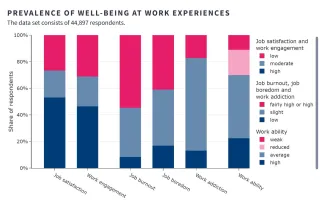Finnish Institute of Occupational Health media release, 13 October 2022
The “How are you feeling?” test assesses the respondent’s well-being at work in six dimensions: job satisfaction, work engagement, occupational burnout, job boredom, work addiction, and level of work ability.
“Measuring well-being at work using several different types of experiences allows us to get a diverse picture of the phenomena – both regarding positive and negative experiences,” says Jaana-Piia Mäkiniemi, Specialist Researcher for the Finnish Institute of Occupational Health.
Nearly 80,000 respondents have already taken the “How are you feeling?” test. An anonymised dataset of approximately 45,000 responses has been collected into the Work-Life Knowledge service, demonstrating the distribution of responses in all of the different dimensions of well-being at work.
More than half of respondents report job satisfaction or job burnout

A little over half of the respondents report their job satisfaction to be high. Unfortunately, just as many estimated that they have significant symptoms of job burnout.
A little les than half of the respondents assessed that their work engagement is high and work ability average.
In responses regarding work addiction and job boredom, the most common level is “slight”.
“Different experiences related to well-being at work are not separate or mutually exclusive, but rather form a whole. For example, the same person can experience slight work addiction and a high level of work engagement. However, there is a clearer negative connection between certain experiences. For example, significant symptoms of occupational burnout do not typically coincide with high levels of work engagement,” says Jaana-Piia Mäkiniemi.
Work engagement is highest in interpersonal work and job burnout the most prevalent in male-dominant sectors
In addition to the overall dataset, the Work-Life Knowledge service also allows exploring experiences of well-being at work by sector, educational level, age and gender.
The responses indicate that job burnout symptoms are common in sectors that involve heavy physical stress that are traditionally male-dominant. Job boredom is also more common in manual labour.
“In addition to physical well-being, these sectors need to pay attention to employees’ psychological well-being and identify ways of bolstering resources that promote meaningful work,” says Jari Hakanen, Research Professor at the Finnish Institute of Occupational Health.
Work engagement is highest in the education sector and social welfare and health care services.
“Previous studies have shown that, even on the European level, people in the much derided social welfare and healthcare and educational sectors experience higher levels of work engagement compared with other sectors. Factors that promote meaningfulness in these professions include a strong sense of purpose, variety of the work and experiences of accomplishment,” says Jari Hakanen.
Work addiction and job boredom are factors of well-being at work that have been studied less, but on which we now have some current data. According to the data, work addiction is most common in the real estate sector and the agriculture, forestry and fisheries sector. Job boredom, on the other hand, is most common in transportation and storage, manufacturing and construction.
See the data in the Work-Life Knowledge service
- Data page: The Finnish Institute of Occupational Health’s “How are you feeling?” well-being at work test provides extensive insight into well-being at work | Work-life knowledge service | www.worklifedata.fi (tyoelamatieto.fi)
- Analysis page: The well-being at work experiences of the respondents to the “How are you feeling” test vary by industrial sector | Work-life knowledge service | www.worklifedata.fi (tyoelamatieto.fi)
- Data page in Finnish: Työterveyslaitoksen Miten voit? työhyvinvointitesti kertoo työhyvinvoinnista monipuolisesti | Työelämätieto | www.tyoelamatieto.fi
- Analysis page in Finnish: Miten voit? -testin vastaajien työhyvinvointikokemukset vaihtelevat toimialoittain | Työelämätieto | www.tyoelamatieto.fi
- Data page in Swedish: Arbetshälsoinstitutets Hur mår du?-arbetsvälbefinnandetest berättar om din arbetshälsa på ett mångsidigt sätt | Arbetslivskunskap | www.tyoelamatieto.fi
- Analysis page in Swedish: Upplevelserna av arbetshälsa hos respondenterna som svarat på Hur mår du?-testet varierar mellan olika branscher | Arbetslivskunskap | www.tyoelamatieto.fi
The “How are you feeling?” test on well-being at work
- The free-of-charge “How are you feeling?” test on well-being at work is part of the Mental Health Support Toolkit developed as part of the Mental health programme for work life: Mind and work | Mental Health Support Toolkit (ttl.fi)
- You will be provided with personal feedback based on your responses, which you can compare with other people’s responses in the Work-Life Knowledge service, if you wish.
For more information, please contact
- Jaana-Piia Mäkiniemi, Specialist Researcher, Finnish Institute of Occupational Health, jaana-piia.makiniemi [at] ttl.fi, +358 50 473 6062
- Jari Hakanen, Research Professor, Finnish Institute of Occupational Health, jari.hakanen [at] ttl.fi, +358 40 562 5433





